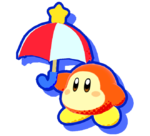WiKirby:Infoboxes and Navboxes
Infoboxes and Navboxes (short for "Information Boxes" and "Navigation Boxes") are special templates which are used to bring a sense of formality to articles. Infoboxes are used at the top of articles to provide basic information about the subject matter, and navboxes are used at the bottom of articles to direct the reader to other related articles in a more direct fashion than categories. A good article will have both of these types of templates lain within them in most cases.
Infoboxes
Infoboxes are placed at the beginning of articles and/or appropriate sections of articles to provide basic information to the reader about the subject matter. There are many different types of infoboxes for specific subject matter, including characters, enemies, copy abilities, and games, among many others. Names of infobox templates must all begin with the prefix "Infobox-".
All types of infoboxes can be found on the infobox category page.
Using an infobox
When adding an infobox to a page, the editor should fill as many relevant parameters as possible, and leave unused/unneeded parameters blank so they do not appear. Ideally, every infobox should contain at least an image and caption. Additionally, the title of the infobox is automatically programmed to display the article title, but the title should be changed manually if need be to remove qualifiers present in the article title or use a more specific title for infoboxes in other sections.
When it comes to listings, subjects should be separated by <br> lines, and listings should be contained within a <small></small> parameter if they get long. Some listings such as "Other games" and "Cameo appearances" should always be made small, regardless of length.
Infobox limits
Infoboxes are pretty when used correctly, but they are also bulky. If a page is using more than three infoboxes, that is a fairly good indicator that the page is too long, and should probably be split in accordance with the Long page policy.
Navboxes should be placed near the bottom of articles, only appearing above the category links. Unless they are navmaps, these boxes should be collapsed by default. Multiple navboxes should be ordered as follows:
- navmaps
- general navboxes, such as Characters, Games, or Copy Abilities
- specific game navboxes (in order of game release)
- specific non-game navboxes (such as the Anime navbox)
All types of navboxes can be found on the navigation category page. Names of navbox templates must all begin with the prefix "Navbox-" unless it is a navmap, in which case it must end with the suffix "NavMap".
Unlike infoboxes, navboxes do not take parameters, and should be placed as is in articles. There are also no hard limits to the number of navboxes that can be on an article, so the editor should place all relevant navboxes on articles.
When changing the contents of a navbox, it is important to keep the contained information organized and separated by • marks. Sequential subjects such as in-game levels, stages, bosses, etc. must be displayed in the order encountered in-game, while other subjects must be displayed in alphabetical order. If a particular listing gets long, the information should be contained within a <small></small> parameter.
There is no solid order to the lists themselves, but generally, "Characters" should go up top, and "Extra" should be at the bottom.
Sometimes an editor may wish to create a new infobox or navbox. When doing this, the editor should be mindful to prevent the new template from appearing too visually similar to an existing one. This is especially important in terms of navboxes. One of the easiest ways to differentiate an infobox or navbox is to change the colors used. For more information about this, see the Creating templates and Using infoboxes pages.
Auto-categories
Some infoboxes and navboxes will automatically generate category links on the pages they are placed in. The editor should be mindful of this when using them. To find out if an infobox or navbox will do this, head to the specific template page.
